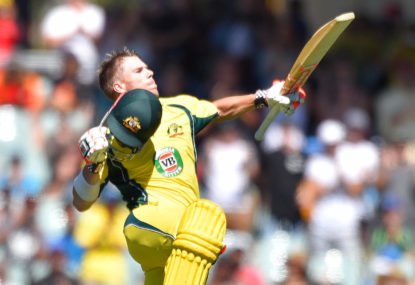Travis Head obliterates RCB in record breaking century... and just wait for the celebration!
RCB have suffered a massive HEAD-ACHE after Travis Head smashed the fastest century by an SRH player in just 39 balls, as they amassed…

Australian batsman David Warner will be among a host of international players forced to downgrade their bats under new laws announced by the Marylebone Cricket Club.
In an attempt to even the contest between bat and ball the MCC will bring in new laws from October limiting the dimensions of a bat to 108mm in width, 67mm in depth with 40mm edges.
Both professional and amateur players will have until October to get used to the laws.
Once October comes around a bat gauge will be used to make sure professional players are complying with the laws.
Ex-cricketers have been calling for the changes for a long time – fearing that bowlers were on a hiding to nothing, especially in the shorter formats of the game.
As well as the bat sizes, the MCC will give umpires unprecedented powers to send off players for breaching the code of conduct. If a player breaches a level three or four offence the umpire can force the player from the field. This includes intimidating an umpire, threatening to assault another player, official or spectator and committing any act of violence on the field. Five penalty runs will also go against the team.
“We felt the time had come to introduce sanctions for poor player behaviour and research told us that a growing number of umpires at grass roots level were leaving the game because of it,” John Stephenson, the MCC’s head of cricket said.
Other law changes including clarification of the ‘mankading’ law which will now allow the bowler to attempt a runout of the non-strikert at any point before they release the ball as opposed to having to do it before the bowler enters their delivery stride.
Batsmen will however be protected from being runout in normal circumstances if they have originally grounded the bat over the crease before it bounces.
“If the bat (held by the hand) or another part of the batsman’s person is grounded beyond the popping crease and this contact with the ground is subsequently lost when the wicket is put down, the batsman will be protected from being run out if he/she is running or diving and has continued forward momentum towards the stumps and beyond,” An MCC statement said.